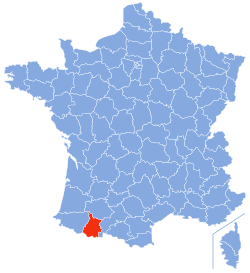|
Hautes-Pyrénées
Hautes-Pyrénées (French pronunciation: [ot piʁene] ⓘ; Gascon/Occitan: Nauts Pirenèus / Hauts Pirenèus ['awts piɾeˈnɛʊs]; Spanish: Altos Pirineos; Catalan: Alts Pirineus ['alts piɾiˈneʊs]; ) is a department in the region of Occitania, southwestern France. The department is bordered by Pyrénées-Atlantiques to the west, Gers to the north, Haute-Garonne to the east, as well by the Spanish province of Huesca in the autonomous community of Aragon to the south. In 2019, its population was 229,567;[3] its prefecture is Tarbes. It is named after the Pyrenees mountain range. HistoryHistorically the area broadly covered by the département known as Bigorre, a territory at times independent but later part of Gascony province. Large parts of the area were held by the English after the Treaty of Brétigny, 1360. In the 16th century, it was part of the Huguenot domain of the monarchs of Navarre, brought to France by Henri IV. For its early history, see Bigorre and Gascony. The département of Hautes-Pyrénées was created at the time of the French Revolution, on 4 March 1790, through the influence of French politician Bertrand Barère, a member of the Convention. Geography Hautes-Pyrénées consists of several distinct geographical areas. The southern portion, along the border with Spain, consists of mountains such as the Vignemale, the Pic du Midi de Bigorre, and the Neouvielle and Arbizon ranges. A second area consists of low-altitude rolling hills. The northern part of the département consists of largely flat agricultural land. Hautes-Pyrénées has two small territorial exclaves—a remnant from the Middle Ages—located within the neighboring département of Pyrénées-Atlantiques. The southern part of the department is sparsely populated and typically have higher elevations while the northern part of the department is highly urbanised and typically have lower elevations than the southern part. Principal townsThe greater Tarbes area is the economic and administrative focus of the département, while Lourdes, the second-biggest city in Hautes-Pyrénées, is dedicated almost exclusively to the religious pilgrimage industry. As of 2019, there are 7 communes with more than 5,000 inhabitants:[3]
DemographicsPopulation development since 1801:
PoliticsThe president of the Departmental Council is Michel Pélieu, first elected in 2011. Current National Assembly Representatives
TourismThe Western Pyrenees National Park covers a significant area, and includes well-known attractions such as the Cirque de Gavarnie and the Pont d'Espagne. The entire area is a favorite destination of hikers and mountain enthusiasts. The area has been known perhaps since Antiquity for its hot springs, and several towns were built around these, most notably Cauterets, Luz-Saint-Sauveur and Bagnères-de-Bigorre. A notable lake in the area is Lac Bleu d'Ilhéou, southwest of Cauterets. There are a number of popular ski resorts in Hautes-Pyrénées such as Barèges-La Mongie, Gavarnie, Luz-Ardiden, Cauterets, Hautacam, Piau-Engaly and Saint-Lary-Soulan. The area is a nearly-permanent fixture on the Tour de France's itinerary, with significantly difficult passes such as the Tourmalet, the Aubisque and the Soulor. A jazz festival is held each year in Luz-Saint-Sauveur: Jazz a Luz. Tarbes hosts an annual horse festival, Equestria, and a Tango festival, Tarbes en Tango.[citation needed]
See also
References
External links
|
||||||||||||||||||||||||||||||||||||||||||||||||||||||||||||||||||||||||||||||||||||||||||||||||||||||||||||||||||||||||||||||||||||||||||||||||||||||||||||||||||||||||||||








